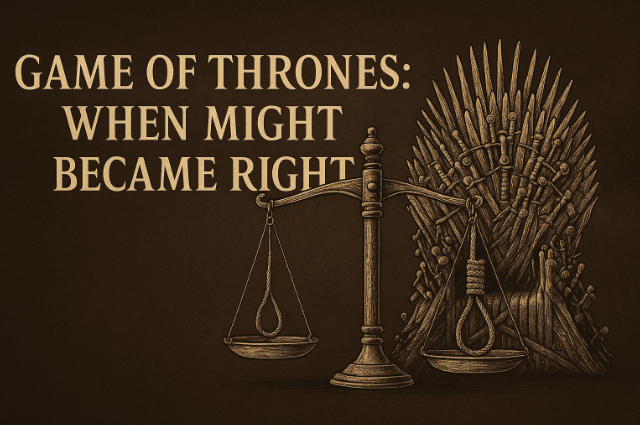
Thinking of the Lannisters and the Starks? Or the Targaryens, maybe? In that world and ours, too, power never asks permission. Justice has never been meant to be fair.
It is just a word used in constitutions and spoken in courtrooms, which are nothing but well-rehearsed performance theatres. It’s a common word in in-laws, slogans, and social media hashtags.
Justice is a hope, fragile and fleeting, a fickle word which is seldom applied and quietly abandoned when power demands.
We live in an age where laws are written in books, but the truth is often debated in the news and social media feeds. In practice, justice depends on who you are, where you live, and what power you hold. This isn’t a modern invention. Long before judges wore fancy clothes and spoke unknown words, history was already showing us the pattern. When those in power felt threatened, justice became a toy. Let’s dive into history’s greatest archives wherein power steamrolled justice as and when it wanted:
The Scottsboro Boys Trial
This is one of the most infamous examples of racial injustice in American legal history, a case where power, prejudice, and fear overruled justice.
In 1931, nine African American teenagers were travelling in a train when a fight broke out between them and some white boys. The white boys left the train and made a false complaint to the authorities about being assaulted by the black boys. When the train stopped in Alabama, two white women, still on board, made a false allegation of rape against the black teens. This marked the start of a cycle of injustices done to the boys, which ended in the 21st century, long after they were all dead.
America was racially prejudiced at that time, and the trials were a formality. Except for one minor boy, the other eight were sentenced straight to death within days of the incident being reported. They weren’t allowed proper legal representation, and their trials included all-white juries. One of the most shocking facts was that multiple medical examinations of the girls proved they were never even touched by the boys. There was little to no evidence to explain if anything criminal had happened on the train. The power of the government and the whites was such an extent that in such cases, the blacks were lynched by mobs even before the trial was completed. A classic example of arrogant power over plain sight justice.
There was some sort of uproar over their case, and the Communist Party USA (CPUSA) and the National Association for the Advancement of Coloured People (NAACP) managed to get the Supreme Court’s attention on this matter. The trials were held again with two changes.
- The Supreme Court said that the boys must be allowed the right to legal representation.
- Black jurors must be included.
And that’s all that happened. The trials were held with the same outcomes. Nothing changed, because nobody defies the power of the state! They were sent to prison and were troubled for years by the whites. Then came a turning point:
‘One of the girls who had alleged rape later testified that nothing had happened on the train.’
Turning point? Wait. Did you just think that the boys might have gotten some relief? Nothing. Power has overruled justice all the time.
Anyways, speeding forward to 2013. More than 80 years after the incident, the state of Alabama pardoned the boys, long after their bodies had decayed in the ground. Well, that’s justice for you!
The ADM Jabalpur vs Shrikant Shukla Case
Also called the Habeas Corpus Case, this is the moment when the Indian Constitution was thrown in the dustbin (metaphorically).
After the National Emergency had been declared by Prime Minister Indira Gandhi, thousands of people were detained across the country on the grounds of… nothing! Well, they hadn’t done anything unlawful at all, but still, power is power, all the rest is in the drawer!
The Supreme Court was brought into the limelight when a simple question was asked of the judges,
‘Do citizens have the right to challenge their unlawful arrest during an emergency?’
The Supreme Court, in most cases, is above the government to maintain the law according to the Constitution. But you know, power has something special in it; power can bend anything and everything in its favour, let alone justice. So, a panel of 5 judges with a 4:1 majority said No, the article on the right to life and liberty can be suspended during an emergency; basically, the state has given you the freedom to live!
Well, you might think of that one judge who ruled against the others. The judge was Justice Hans Raj Khanna, who said that the gift of life and liberty is not of the state to have control over it. Well, you speak against the power and won’t get punished? Justice Khanna was a frontrunner for the position of Chief Justice, and well, he got bypassed. The government wasn’t too happy with him for his decision. He resigned soon after, in quiet protest.
Again, fast forward to 2017, when the Supreme Court finally thought that what happened might have been wrong and affirmed that the right to life and liberty during an emergency can’t be suspended.
Conclusion
So, there you have two powerful cases of power vs justice in two of the biggest democracies in the world. Justice may not always be blind, but when people in power command it, it can be deliberately blindfolded. Such scenes might be cool and thrilling to watch in films, but in reality, these small predicaments have changed the course of history and created issues that still linger around us today. Injustice often happens in full view, with everyone watching and yet no one stopping it.
Power doesn’t hide in shadows. It signs orders in daylight, smiles from thrones, and watches as justice walks itself quietly to the gallows.
